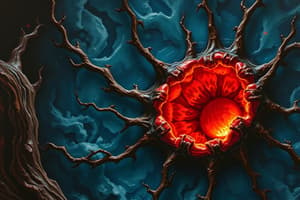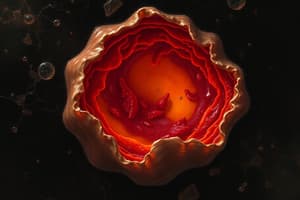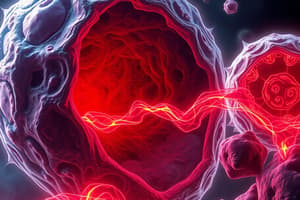Podcast
Questions and Answers
What is a characteristic feature of autophagic cell death?
What is a characteristic feature of autophagic cell death?
- Condensation of chromatin
- Presence of phagocytes engulfing the cells
- Formation of necrotic tissue
- Massive autophagic vacuolization of the cytoplasm (correct)
What process marks the completion of the autophagic pathway?
What process marks the completion of the autophagic pathway?
- Release of cytosolic Ca2+
- Separation of daughter nuclei during mitosis
- Degradation of autophagosome content by lysosomes (correct)
- Formation of protein aggregates
Which cell death modality is specifically induced by the loss of attachment to the substrate?
Which cell death modality is specifically induced by the loss of attachment to the substrate?
- Mitotic catastrophe
- Corneification
- Excitotoxicity
- Anoikis (correct)
What happens during excitotoxicity in neurons?
What happens during excitotoxicity in neurons?
Which of the following describes mitotic catastrophe?
Which of the following describes mitotic catastrophe?
What is the main characteristic that distinguishes apoptosis from necrosis?
What is the main characteristic that distinguishes apoptosis from necrosis?
What triggers necrosis as opposed to apoptosis?
What triggers necrosis as opposed to apoptosis?
Which of the following best describes programmed cell death?
Which of the following best describes programmed cell death?
What does the Nomenclature Committee on Cell Death (NCCD) aim to clarify?
What does the Nomenclature Committee on Cell Death (NCCD) aim to clarify?
Which of the following options is a feature of apoptotic cell death?
Which of the following options is a feature of apoptotic cell death?
How can cell death be categorized based on its triggering mechanisms?
How can cell death be categorized based on its triggering mechanisms?
Which cellular process is likely to lead to permanent plasma membrane permeabilization?
Which cellular process is likely to lead to permanent plasma membrane permeabilization?
Which of the following is NOT a common cause of necrosis?
Which of the following is NOT a common cause of necrosis?
What is the defining characteristic of a cell undergoing apoptosis?
What is the defining characteristic of a cell undergoing apoptosis?
Which of the following processes indicates irreversible cell death?
Which of the following processes indicates irreversible cell death?
What is the role of caspases in apoptosis?
What is the role of caspases in apoptosis?
Which pathway is initiated when a cell senses stress and kills itself?
Which pathway is initiated when a cell senses stress and kills itself?
What morphological change is associated with a dead cell?
What morphological change is associated with a dead cell?
What initiates the clearance of apoptotic cells by neighboring cells?
What initiates the clearance of apoptotic cells by neighboring cells?
Which of the following is NOT classified as a type of cell death mentioned?
Which of the following is NOT classified as a type of cell death mentioned?
What is a characteristic feature of cells undergoing immunogenic cell death?
What is a characteristic feature of cells undergoing immunogenic cell death?
How does the extrinsic pathway of apoptosis differ from the intrinsic pathway?
How does the extrinsic pathway of apoptosis differ from the intrinsic pathway?
Which alteration signifies that a cell has crossed the point-of-no-return?
Which alteration signifies that a cell has crossed the point-of-no-return?
Which initiator caspase activates downstream effector caspases in the intrinsic pathway?
Which initiator caspase activates downstream effector caspases in the intrinsic pathway?
What role does cytochrome c play in apoptosis?
What role does cytochrome c play in apoptosis?
Which of the following correctly describes initiator caspases?
Which of the following correctly describes initiator caspases?
Which pro-apoptotic signal is NOT mentioned as an inducer in the content?
Which pro-apoptotic signal is NOT mentioned as an inducer in the content?
What initiates the extrinsic pathway of apoptosis?
What initiates the extrinsic pathway of apoptosis?
Which of these is a role of effector caspases?
Which of these is a role of effector caspases?
What is the result of membrane contraction during apoptosis?
What is the result of membrane contraction during apoptosis?
Which initiator caspase is specifically associated with the extrinsic pathway?
Which initiator caspase is specifically associated with the extrinsic pathway?
What occurs to caspases during activation?
What occurs to caspases during activation?
Which statement accurately describes pro-caspases?
Which statement accurately describes pro-caspases?
What mediates the formation of membrane protrusions in cells?
What mediates the formation of membrane protrusions in cells?
Which type of cell death leads to the fragmentation into apoptotic bodies?
Which type of cell death leads to the fragmentation into apoptotic bodies?
What activates necroptosis?
What activates necroptosis?
What happens during necrosis?
What happens during necrosis?
What is NOT a characteristic of necroptosis?
What is NOT a characteristic of necroptosis?
What type of signaling molecules do dying cells emit to attract phagocytes?
What type of signaling molecules do dying cells emit to attract phagocytes?
What is a feature of necroptosis compared to necrosis?
What is a feature of necroptosis compared to necrosis?
Which consequence is associated with necrosis?
Which consequence is associated with necrosis?
What role do phagocytes play after cell death?
What role do phagocytes play after cell death?
Which organelle undergoes swelling during necrosis?
Which organelle undergoes swelling during necrosis?
Flashcards
Cell Death
Cell Death
The irreversible breakdown of essential cell functions, leading to loss of cell integrity. This includes disruption of ATP production and the ability to maintain a balanced redox state.
Apoptosis
Apoptosis
A form of programmed cell death that is orderly, controlled, and often needed for normal tissue development and maintenance.
Necrosis
Necrosis
An uncontrolled and often traumatic form of cell death that is initiated by damage to the cell, leading to inflammation.
Triggers of Cell Death
Triggers of Cell Death
Signup and view all the flashcards
Mechanism of Cell Death
Mechanism of Cell Death
Signup and view all the flashcards
Importance of Understanding Cell Death
Importance of Understanding Cell Death
Signup and view all the flashcards
NCCD Guidelines
NCCD Guidelines
Signup and view all the flashcards
Types of Cell Death
Types of Cell Death
Signup and view all the flashcards
Autophagic cell death
Autophagic cell death
Signup and view all the flashcards
Mitotic catastrophe
Mitotic catastrophe
Signup and view all the flashcards
Anoikis
Anoikis
Signup and view all the flashcards
Excitotoxicity
Excitotoxicity
Signup and view all the flashcards
Corneification
Corneification
Signup and view all the flashcards
What is apoptosis?
What is apoptosis?
Signup and view all the flashcards
What is the role of cytochrome c in apoptosis?
What is the role of cytochrome c in apoptosis?
Signup and view all the flashcards
What are caspases and how are they activated?
What are caspases and how are they activated?
Signup and view all the flashcards
What's the difference between the intrinsic and extrinsic pathways of apoptosis?
What's the difference between the intrinsic and extrinsic pathways of apoptosis?
Signup and view all the flashcards
How is cell death determined morphologically?
How is cell death determined morphologically?
Signup and view all the flashcards
What's the 'point-of-no-return' in cell death?
What's the 'point-of-no-return' in cell death?
Signup and view all the flashcards
What are ADCD, ICD, LDCD, and MPT?
What are ADCD, ICD, LDCD, and MPT?
Signup and view all the flashcards
How are dying cells recognized by phagocytes?
How are dying cells recognized by phagocytes?
Signup and view all the flashcards
What are the morphological features of apoptosis?
What are the morphological features of apoptosis?
Signup and view all the flashcards
When is cell death reversible?
When is cell death reversible?
Signup and view all the flashcards
Necroptosis
Necroptosis
Signup and view all the flashcards
Fragmentation in Apoptosis
Fragmentation in Apoptosis
Signup and view all the flashcards
Phagocytes
Phagocytes
Signup and view all the flashcards
Find-Me Signals
Find-Me Signals
Signup and view all the flashcards
Eat-Me Signals
Eat-Me Signals
Signup and view all the flashcards
Membrane Protrusions
Membrane Protrusions
Signup and view all the flashcards
DAMPs (Damage-Associated Molecular Patterns)
DAMPs (Damage-Associated Molecular Patterns)
Signup and view all the flashcards
RIPK3 (Receptor-interacting protein kinase-3)
RIPK3 (Receptor-interacting protein kinase-3)
Signup and view all the flashcards
What are caspases?
What are caspases?
Signup and view all the flashcards
How do initiator caspases work?
How do initiator caspases work?
Signup and view all the flashcards
What's the other name for caspases?
What's the other name for caspases?
Signup and view all the flashcards
What triggers the caspase cascade?
What triggers the caspase cascade?
Signup and view all the flashcards
How are pro-caspases activated?
How are pro-caspases activated?
Signup and view all the flashcards
What is the extrinsic apoptosis pathway?
What is the extrinsic apoptosis pathway?
Signup and view all the flashcards
What is the intrinsic apoptosis pathway?
What is the intrinsic apoptosis pathway?
Signup and view all the flashcards
What is the apoptosome?
What is the apoptosome?
Signup and view all the flashcards
What are effector caspases?
What are effector caspases?
Signup and view all the flashcards
What happens to the cell membrane during apoptosis?
What happens to the cell membrane during apoptosis?
Signup and view all the flashcards
Study Notes
Cellular Biology I - Cell Death Mechanisms
- Cell Death: Irreversible degeneration of vital cellular functions, culminating in loss of integrity (permanent plasma membrane permeabilization or fragmentation) occurring as a decision to maintain tissue homeostasis.
- Immunogenic Cell Death: A final decision by the cell to maintain tissue homeostasis, a process crucial for tissue maintenance.
- Types of Cell Death:
- Lysosomal Cell Death: A form of cell death involving lysosomal enzymes.
- Apoptosis: Programmed cell death, an orderly and highly regulated process maintaining tissue homeostasis. Often characterized by DNA damage.
- Pyroptosis: A form of programmed cell death involving inflammatory responses.
- Necroptosis: Unregulated (non-programmed) cell death. Characterized by swelling of the cell, breakdown of the membrane, and inflammation.
- Ferroptosis: A form of cell death caused by iron accumulation.
- Oxeiptosis: Cell death mediated by oxidative stress
- Parthanatos: A form of programmed necrosis resulting from DNA damage. -NETosis: A form of programmed cell death that involves the formation of neutrophil extracellular traps (NETs).
- Autosis: Self-destructive cellular degradation of organelle components.
- Entosis: One cell engulfing another cell.
- Alkaliptosis: Cell death triggered by an increase in intracellular pH; characterized by cell membrane disruption.
Morphological Criteria for Cell Death
- Membrane Integrity: Loss of integrity in the plasma membrane; this is often assessed with vital dyes (e.g., PI).
- Cellular Fragmentation: Breakdown of a cell into discrete bodies(apoptotic bodies).
- Phagocytosis: Adjacent cells engulfing the corpse.
Necrosis
- Characteristics: Unprogrammed, overwhelming insult, extreme physical/chemical stress or osmotic shock.
- Morphological changes: Swelling of cell and organelles, membrane breakdown, and leakage of contents.
- Outcome: Inflammation is induced by cellular components and death.
- Types of Necrosis:
- Coagulative: Protein denaturation
- Liquefactive: Degradation/breakdown to liquid
- Caseous: Granular appearance
Apoptosis - Intrinsic Pathway
- Initiation: Occurs when a cell senses internal stress or damage involving mitochondria, DNA damage, endoplasmic reticulum stress , and hypoxia (low oxygen) inducing cell death.
- Key Players:
- Bcl-2 family members: Regulate mitochondrial outer membrane permeabilization (MOMP), including BAX, BAK, BID ,and p53.
- Mitochondria: Release of cytochrome c
- Apaf-1: Activates Procaspase-9.
- Executioner caspases: (Caspases-3, 6, and 7) lead to cell disassembly.
Apoptosis - Extrinsic Pathway
- Initiation: External signals (e.g., death receptors, TNF, TRAIL) induce apoptosis involving extracellular triggers.
- Key players:
- Death receptors: (e.g., Fas, TNF Receptor, TRAIL receptors).
- Adaptor proteins: FADD, TRADD
- Initiator caspases: (e.g., Caspase-8) activating the cascade.
- Executioner caspases: (e.g., Caspases-3, 6, and 7) lead to cell disassembly.
Caspase Cascade
- Caspases: Cysteine proteases that cleave specific proteins leading to cellular disassembly.
- Initiator caspases: trigger the apoptosis cascade and activate downstream effectors.
- Effectors: Activate downstream caspases and induce cell death.
Other Cell Death Modalities
- Necroptosis: A form of programmed necrosis, triggered by death receptors, foreign microbial nucleic acids.
- Pyroptosis: Programmed cell death related to pathogen inflammation
- Autophagic cell death: Elimination of damaged or unneeded cell components through lysosomal fusion.
- Ferroptosis: Cell death involving iron accumulation/oxidative stress
- Mitotic catastrophe: Excessive/abnormal cell division leading to cell death.
- Anoikis: Programmed cell death that induces cell detachment
- Excitotoxicity: Result of overstimulation causing excessive calcium influx
- Corneification: Final stage of epidermal cell differentiation.
Studying That Suits You
Use AI to generate personalized quizzes and flashcards to suit your learning preferences.




